How Governments Solve The Short Term Debt & High Inflation Dilemma
By Daniel R. Amerman, CFA
Overview
Misunderstandings can be quite expensive for investors, and this article will examine two common but mistaken beliefs about short-term government debt and inflation. The first belief is that because much of government debt is short term, and short term rates are likely to eventually rise rapidly with rising inflation, this means that the debt can't truly be inflated away. Therefore, many people think that even in a highly inflationary environment, the inability of the government to inflate away its debt means that literal bankruptcy becomes highly likely or inevitable.
A related belief is that Treasury bills in the US (and their equivalents in other nations) may be a surprisingly good investment for keeping up with inflation. The theory is that there is likely to be an initial loss when inflation first accelerates, but once short-term interest rates catch up with inflation, the investor is effectively protected.
As we will convincingly demonstrate herein, a government can use inflation to redistribute wealth from short term investors to the government - but it isn't actually the inflation that does it. The wealth redistribution is very real, but it comes from effectively taxing inflation, rather than from destroying the purchasing power of the investment principal directly. Ironically, most people are investing for the wrong risk, and are being distracted by what doesn't work for the government, while ignoring the little understood vehicle that governments around the world can use to avoid bankruptcy by appropriating the net worth of investors.
In other words, everyone is watching the prominently visible inflationary right hand of the government and saying "that's not going to work, the government can't use inflation to destroy the value of short-term debt." Meanwhile, the unseen left hand of the government is stealthily reaching around into the wallets of an entire nation, and using the little understood intersection of inflation and tax policy to remove most of the contents, thereby averting government bankruptcy while cheating an entire generation of investors. Keep your eye on that left hand, however, and not only can you protect yourself, but come out ahead, through reversing inflation taxes.
The Compelling Reason Why The "Smart Money" Likes T-Bills
When people anticipate rising interest rates, a common response is to shorten the term of savings instruments. For example, an investor might move to one year and under CDs or Treasury bills, instead of pursuing the higher interest rates of two, five and ten year alternatives. Merely buying short term investments during a time of high and rising inflation may seem an unsophisticated and naïve strategy, but some quite sophisticated investors within the mainstream investment community think this simple option is very much underrated. With the right assumptions, a short-term government security investment strategy can perform surprisingly well in an environment which destroys the value of most fixed-rate investments, as illustrated below.
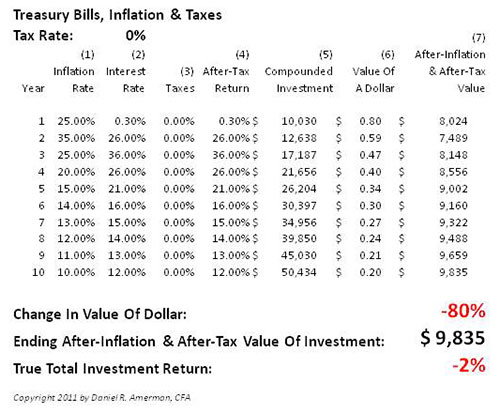
(The columns above are individually explained in more detail beneath the similar chart in the next section.)
The scenario shown above could be called "the late 70s and early 80s on steroids". As shown in column 1, inflation surges to a 25% annual rate in the first year, peaks at a 35% rate in the second year, then begins a long decline while remaining high. Column 6 tracks the value of the dollar with the scenario and shows that it has been cut in half (to 47 cents) by the end of 3 years, and the value of the dollar is down to 20 cents by the end of 10 years.
The investment assumption is that we buy one year (364 day) T-bills once a year at a rate slightly (1%) above the previous year's official inflation rate, which is roughly in line with long-term historical experience. So the 25% rate of inflation in year one means that our second year T-bill investment rate is 26%; and the 15% rate of inflation in year five means that at the beginning of year six, we're able to buy a T-bill at a 16% yield (the exception is the first year, which is based on the current market).
For an intuitive rather than mathematical explanation, this strategy is based on buying short term securities - not money market funds - that in this case have a one year maturity. The key assumption is that there is an inflation "event" that does not completely spin out of control, and that what goes up must also come down. So, the investment strategy steadily loses when inflation is rising, as actual inflation exceeds interest rates in each period. However, once the peak occurs, then the debt acts like a descending staircase, with each "step" consisting of a locked-in interest rate that is above the slowly falling rate of inflation. Each time the debt resets, a new stair step is formed. The investor gains by earning above-inflation returns with each downward step, and so long as this is a cycle that returns to a low rate of inflation, the gains coming down the inflation staircase offset the losses going up the staircase, and the investor has maintained value.
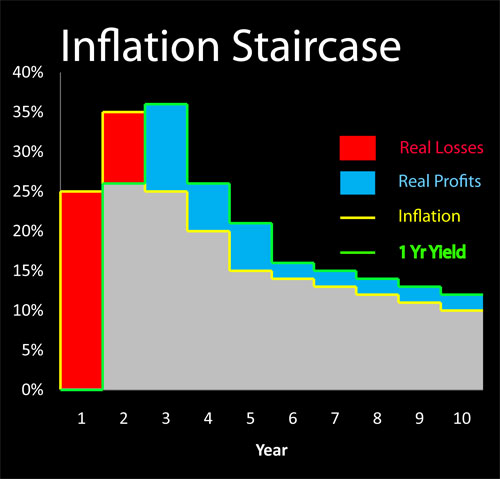
As can be seen in this illustration, from a governmental perspective, using inflation would have been an unsuccessful strategy for wiping out the value of short-term debt obligations (though it would have been highly effective for long-term bonds). Despite the assumption of an 80% destruction of the value of the dollar, the payment of above-inflation-rate interest payments on the descending portion of the inflation staircase would have offset the gains from paying below-inflation-rate interest rates on the way up, and the government would be left with almost the same inflation-adjusted value of debt outstanding (when including the assumed reinvestment of after-tax interest payments) as it did before the inflation event. With these particular assumptions - inflation indeed does not prevent government bankruptcy, if too much of governmental borrowing is short term.
Adding The Left Hand
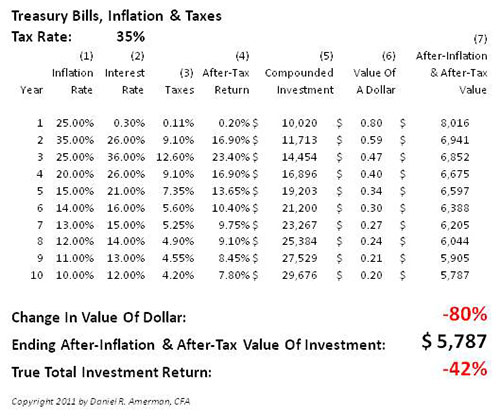
The above chart is identical to the first chart, where investors retained 98% of their beginning real net worth, but with one key exception – this time we include taxes. That changes everything. Let's quickly review the columns one by one to make sure you see how.
Column (1) is the average rate of inflation over the year.
Column (2) is the prior year's official rate of inflation plus 1%, as previously explained, with the exception of the first year that reflects the current environment.
Column (3) is the taxes on our interest earnings, calculated at the 35% tax rate assumption shown in the upper left of the chart. Going to the 2nd year (second row), our interest earnings are 26% and we are paying taxes at a 35% rate, so we have to remit 9.1% (26% X 35%) in interest income back to the government in the form of taxes.
Column (4) shows our after-tax return, and sticking with our second row example, if we get an interest payment of 26%, but 9.1% must be paid back in taxes, then that leaves us with 16.9%.
Column (5) begins with the previous year's investment amount, which is $10,020 from row one, and adds to it the after-tax earnings from the current year at a 16.9% rate in this case, leaving us with $11,713 after paying taxes at the end of year two. (Please note this is using simple annual interest rather than the actual somewhat more complicated calculations used for actual treasury bill yields.)
Having almost $12,000 by the end of year two, compared to starting with 10,000, is all is good and well until we reach column 6, which shows us what the value of the dollar is after discounting for our column (1) inflation rates. The purchasing power of a dollar is only 59 cents by the end of year two.
In column (7), we adjust the after-tax compounded value of our investment from column (5) by the ending value of the dollar in column (6), and we see the value of our investment on both an after-inflation and after-tax basis, which is down to $6,941.
Looking at columns (1) and (2), we see the exact same inflation and interest assumptions that we saw in the first chart, where we kept 98% of our after-inflation investment value intact. But when we go to the bottom right corner of this second chart, we find that after 10 years - 42% of our investment value is gone.
Where did the missing 40% of our starting net worth go? Straight to the government. Simply put: government fiscal and monetary policy creates inflation. The government pays us interest income to offset the effects of government induced inflation, once an inflationary environment is recognized by the "market". However, government tax policy does not recognize the existence of inflation as an expense.
Tax "loopholes" are not just for taxpayers, and the governments of the world have an extraordinarily powerful "loophole from hell" of their own when it comes to unknowing investors and inflation. The higher the rate of inflation, the higher the interest payments on short-term government (and other) debt, and the higher the interest income we must state in our tax returns compared to our starting net worth. Thus, the higher the taxes we must pay, and the more of our starting net worth that ends up belonging to the government.
This effectively hangs a lead weight around our necks when it comes to swimming to try to keep up with inflation. And the higher the inflation rate goes, because of irresponsible government fiscal and monetary policy, the heavier that lead weight grows.
Effectively, inflation turns short term interest-bearing instruments into an asset tax. And the higher the rate of inflation - the more of your starting net worth that the government takes each year. This is true for government and corporate bonds, money market accounts and certificates of deposit.
Rising Tax Rates
The problem goes well beyond debt, for inflation shelters are also subject to the pernicious effects of inflation taxes, whether we're talking about real estate, silver, gold or any other form of hard asset or security that is purported to keep up with inflation. However, interest payments have a particular problem in that they are usually taxed as "ordinary income" rather than long term capital gains, meaning these ongoing interest payments are likely to be taxed at a higher rate than alternative inflation shelters. They are taxed at higher rates today, and are likely to be taxed at still higher rates in the future, given the enormous amount of government borrowings in combination with the rapidly approaching Boomer retirement financial crisis.
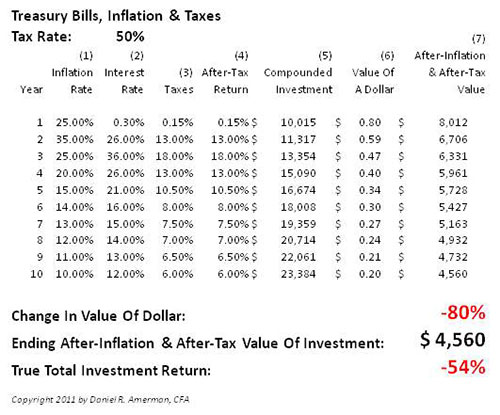
The chart above is the same as the preceding chart, with one key change – we've raised the tax rate to 50% on ordinary income. From a historical perspective, particularly for a government in fiscal crisis, this is not an extraordinary assumption. However, when we make this simple change to our illustration, then more than half of our starting net worth ends up belonging to the government rather than us.
Keep in mind that there are two forces at work here. With the strategy of investing in short-term government debt, the higher the inflation rate, then the more of our net worth belongs to the government. And the higher the tax rate, the more of our beginning net worth that belongs to the government. So if you are anticipating a future that includes both high rates of inflation and higher tax rates – then understand that entering into a strategy of this sort just means that inflation taxes are likely to get you both ways, with potentially devastating implications for your net worth.
The Inflation Staircase Revisited & The Fifth Reason
Let's return to our governmental perspective and revisit our "Inflation Staircase" with an identical inflation scenario, but with a 50% tax rate. The illustration below graphically and intuitively shows what happens - there are no more blue stairs, instead there is a sea of red, with the entire staircase buried under the annual rates of inflation. This is because when you are paying 50% taxes on a high rate of inflation - the height of each stair has been cut in half. This greatly accelerates investor losses on the way up, and generates continuous investor losses on the way down as well.
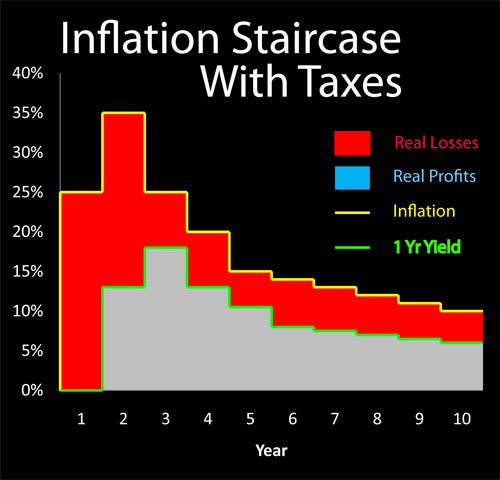
From the government's perspective - every bit of red is a reduction in debt, without actually having paid for it in real (inflation-adjusted) terms. The theory that the government can't inflate its way out of debt is based on the notion of a timid government making a half-hearted attempt, and either not collecting taxes or keeping taxes modest. What the illustration above shows is the overwhelming incentive for a bankrupt government to go full throttle when it comes to raising inflation rates in step with tax rates.
Inflation is a powerful way of wiping out the value of medium and long term debts, but as previously illustrated, it doesn't work all that well with short term debt. So, if a government has a powerful need to wipe out as much as possible of the value of its debts, it must employ a second tool - the "left hand" of inflation taxes quietly pickpocketing most of the contents of most of our wallets. A "left hand" that never directly appears on a tax return, and is never explicitly voted on in a legislature. It is a near invisible "left hand" when it comes to both conventional investor education and investor preparations. It is a "left hand" that also plunders investor wealth when it come to precious metals, equities, real estate or nearly any other method of retaining wealth that is attempted using a naive investment strategy (i.e. ignoring inflation taxes).
For a government seeking to avoid bankruptcy, the deployment of inflation taxes is a far from accidental strategy. Indeed, the revenue benefits of inflation taxes could be added as a Fifth Reason for destroying the dollar, to my previous article linked below, "Four Reasons Why The Government Is Destroying The Dollar".
http://danielamerman.com/articles/Four.htm
The Tail Wagging The Dog
Many people, if they are aware of inflation taxes at all, place them in the role of minor technicality. "Inflation" and "taxes" are both deeply unpleasant words, and we would rather not think about them, particularly in combination. For the minority (at this stage) who are deeply concerned about inflation, as well as the commentators advising them, the most common approach is to simply ignore the problem.
Before mentally filing this article in the round circular bin of "bad things I don't want to think about", however, take another look at the Inflation Staircase illustrations. With the no tax illustration, look at the red investor losses on the staircase going up, the offsetting blue profits going down the other side, and the ending bottom line. Inflation itself - that boldly prominent "right hand" of government fiscal and monetary policy, even while destroying 80% of the value of the dollar - only took 2% of the real value of the investor's net worth. While the average retirement account investor who is uneducated about what is going on with the current global economy is likely to see their savings destroyed by inflation, for more informed investors there are actually quite an array of strategies that can handle the "right hand" of inflation.
Next, look at the sea of red in the Inflation Staircase With Taxes example. No blue, just a direct redistribution of wealth from the investor to the government that occurs each and every year, regardless of the rate of inflation that year. The red is an asset tax that takes 54% of the starting net worth of the investor and redistributes it directly to the government.
The "right hand" of inflation took 2% of investment value. The little understood "left hand" of inflation taxes took an additional 52% of investor savings value and moved it to the government. That unpleasant little "technicality" that is so commonly ignored even in the contrarian investment community, INFLICTED 26X THE DAMAGE TO THE INVESTOR when compared to the damage caused directly by inflation itself. Inflation taxes aren't some trivial nuisance, but are the very Heart & Core of how a bankrupt government directly helps itself to the savings of tens of millions of investors, in order to avoid bankruptcy, while keeping the special interests' wealth transfers flowing.
Consider the dilemma of the government with the scenarios shown:
If it weren't for the right-hand of inflation - there would be crushing debt without tax revenues, as the taxes collected on the current 0.30% one year interest rates are trifling.
If it weren't for the left-hand of inflation taxes - inflating away short-term debt wouldn't work, and short term investors would manage to maintain 98% of their after-tax and after-inflation net worth.
But, with both right and left hands working together - 54% of what used to belong to you is now government property. This is true not just of Treasury security investors, but also money market investors, CD investors, and even interest-bearing checking account savers.
The government needs both hands or it can't pay its bills. So let me suggest - the government is coming after all savers with both hands.
Hanging On To Your Wallet (Or Purse)
What was covered in this article is not complex theory, but rather the fundamental firmament underlying all of our investment plans and future lifestyles. If you are distracted watching the right hand of that kid on the subway, it is the left hand that will be cleanly removing your wallet. Learn to see the left hand and anticipate its movements - or lose your wallet. It's that simple.
The "left hand" is coming after your wallet with all types of taxable bond market investing, bank CDs, TIPS, and money market accounts. The "left hand" of the government is also coming after your wallet when it comes to precious metals, stocks, commodities and other financial and tangible asset strategies.
The wallet is your future standard of living. If you decide not to worry about the wallet and the "left hand" of government removes it - there goes perhaps half of your future standard of living, at least during the years when you were counting on having investments to help support you. Or you may lose more than half of your future standard of living, if inflation and tax rates turn out to be higher than those shown.
The world is more complex in its unfairness than most people realize, but we do have free will when it comes to trying to defend what we have built. I've been educating many people on these issues for some years now, and I'm finding the behavioral choices and related psychology, perhaps even the morality, to be fascinating.
What this article and related articles are intended to do is to briefly and brightly illuminate the pickpocket in action, to show the "left hand" in motion towards your wallet. The glimpse will be brief, as the subject is little covered by most other writers, despite its central importance.
When someone discovers the pickpocket and clearly sees that left hand - I know from experience that many people do act to protect their "wallets", so to speak. They promptly and proactively transform their financial profiles to deal with the problem, and protect their future standard of living.
Where the issue gets fascinating is with the many other people who briefly see the pickpocket with clarity, who see the left hand in motion towards their wallet - but do nothing. They take the knowledge and ignore it. It may be inconvenient. It may be profoundly uncomfortable. It may cast into doubt every aspect of their financial strategy - and even their financial philosophy. So they choose not to see, and the problem is removed from their sight. Perhaps along with half of their future standard of living in retirement.
What is also fascinating are the related moral questions. We see a pickpocket. For our defensive strategy, we choose to close our eyes and wish away the existence of the pickpocket. Alas, we still get robbed, and we pay the price with decades of potential reduced standard of living or even impoverishment. Who is to blame?
Is it the pickpocket? Why of course, it is entirely the pickpocket's fault. Yet, in this flawed world of ours, pickpockets have existed for as long as there has been money, even as governments have been used by insiders to loot from the general population since the very first governments.
Is it the world's fault for being complex in its unfairness and damned inconvenient in general?
Should we share any of the blame if we know the pickpocket is there, but we prefer to pretend it isn't, and we then pay the price for the rest of our lives?
I can't say that I know all of the answers, but the behavioral and moral questions are fascinating.








